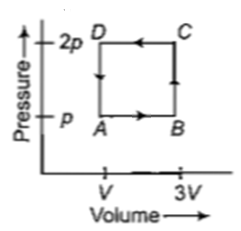My Notes
A system is taken from state \(A\) to state \(B\) along two different paths \(1\) and \(2.\) If the heat absorbed and work done by the system along these two paths are \(Q_1,Q_2\) and \(W_1,W_2\) respectively, then
1. \(Q_1=Q_2\)
2. \(W_1=W_2\)
3. \(Q_1-W_1=Q_2-W_2\)
4. \(Q_1+W_1=Q_2+W_2\)
In a given process, dW = 0, dQ < 0, then for the gas:
1. Temperature increases
2. Volume decreases
3. Pressure decreases
4. Pressure increases
An ideal gas with adiabatic exponent y is heated at constant pressure and it absorbs Q heat. What fraction of this heat is used to perform external work?
1.
2.
3.
4.
Figure below shows two paths that may be taken by a gas to go from a state A to a state C. In process AB, 400 J of heat is added to the system and in process BC, 100 J of heat is added to the system. The heat absorbed by the system in the process AC will be-
1. 380 J
2. 500 J
3. 460 J
4. 300 J
A thermodynamic system is taken through the cycle ABCD as shown in figure. Heat rejected by the gas during the cycle is

1. 2 pV
2. 4 pV
3.
4. pV

